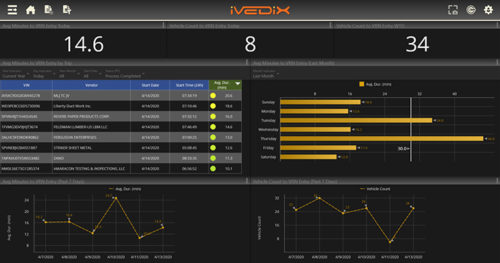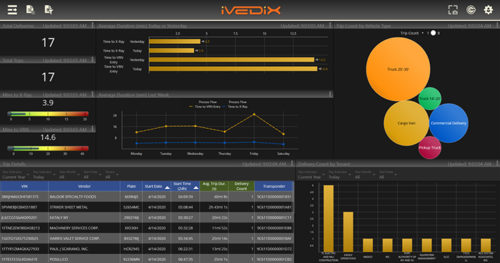RFID Tracking and Analysis Success Story
Summary
A sprawling 15-acre high-target government facility of office buildings, retail stores, and a high-volume commuter hub uses a scheduling system that relies on multiple points of manual data capture and entry. The manual system organizes a pre-approved list of expected vehicles, such as commercial deliveries, and logs entry and exit times in order to process checkpoints and vehicle location. It also determines if the management of the campus meets signed Service Level Agreements. Tenant and commercial volumes are expected to rise as the campus extends. Add in the complexity of an underground portion of the roadway and the facility sees a significant operational and security need to automate vehicle tracking, as well as control it from a centralized Situation Room.
The Problem
The existing security and scheduling system relies on manual checkpoints – campus entry/exit, screening entry/exit, loading dock check-in/check-out. As a 24 hour operation, significant time and resources are needed to manually collect and compile vehicle throughput data. This approach is neither sustainable nor extensible. It does not provide complete visibility and real-time data to make on-demand operational and security decisions. Traffic management is a daily unorganized scramble. Since the personnel handling these checkpoints work for different third party staffing companies, all with different priorities, the manual tracking approach results in poor and inefficient data quality.
In addition the current system cannot track the full trip of a vehicle, especially as it travels through the underground roadway. Finally, when reports of vehicle traffic are needed, operators must search for information in different parts of the database and extract what is needed – another inefficient process.

The Challenge
The Facility, Security, and Operations departments must gain a real-time ability to monitor vehicle progress and dwell times without having to manually monitor more than forty video cameras or hire 24-hour personnel to staff posts throughout the campus and below-grade roadway.
Varying technological options can easily cover more locations than the current manual process, but the unique nature of an underground roadway with dense concrete walls limits the line of sight for some automated solutions.
Essential Capabilities to be addressed:
• Real-time, automated monitoring of the roadway that enables Operations and Security users to track vehicles entering, traversing, loitering, and exiting the campus
• Configurable alert (alarm) notification features for exceeded thresholds (such as total trip time, time to screening, time through security screening, vehicle dwell in critical locations)
• Ability to aggregate subprocess intervals for operational efficiency analysis
• Integration with existing systems
• Works on metal and in potential subzero conditions
• Improve data accuracy and reliability to support different types of analysis
• Maximizing/expediting truck throughput and security
• Tools with intuitive user interface for use by Operations and Security personnel in their Command Center hub

The Solution: RFID Vehicle Tracking & iVEDiX IoT Core
Using active RFID tags and readers the iVEDiX platform provides automated data collection for vehicles traversing the campus (above and below grade). Not only does this eliminate the more costly and inefficient manual process, but it also provides on-going operational cost-saving while securing reliable data to analyze and assess compliance with stakeholder agreements.
Active tags are placed on vehicles as they enter the campus via a credentialing checkpoint. From there, numerous omnidirectional antennas and gateways are placed strategically above and below grade to provide full coverage of the campus, collect data and monitor vehicles as they travel the roadway network.
The ATEX certified tags chosen for this implementation work on metal and eliminate the ‘bounce’ of signals to eliminate false reads. This also creates maximum coverage while reducing costs. The 433MHz frequency selected is a lower power solution that extends battery life and travels farther for wider coverage. It communicates over a proprietary protocol to ensure security. This technology is ideal for the harsh conditions this application faces. With a long battery life it allows for seamless commissioning of the vehicle tags with minimal adjustment to the business process.

Managing What They Can’t See
Actionable intelligence is accessible through both iVEDiX’s web-based Platform Management Center (PMC) and iVEDiX Glass, a native Windows, and mobile data analytics application.
The iVEDiX IoT Core engine processes and analyzes the event stream data in real-time providing Operations and Security personnel immediate visibility to the vehicles. Instant alerts are raised in the PMC and notifications distributed from a configurable Rules engine.
Now Operations and Security know exactly who is within the campus at any given time. The iVEDiX solution shows where vehicles are and where they have been; how long they have been at each checkpoint, and how long it took them to get there. By obtaining a more complete database of information between check-in and check-out, management can now assess the efficiency of operations for continual improvement such as reducing expenditures associated with process delays.
RFID Integration with the iVEDiX IoT Core adds value by enhancing the efficiency, accuracy, and completeness of current and historic vehicle tracking data. As a result, the monitoring of the facilities will improve. The enhanced data will also be used to inform operational and procedural decisions. The enhanced digital system not only gives Operations the ability to monitor vehicle activity for the day but provides the intelligence and visualization to establish various key performance indicators to track and measure against. These KPIs offer value-added information necessary to manage and improve efficiencies.
From central Operational and Security hubs, single personnel can both quickly monitor vehicle placements on a high-level 2D map of the campus, as well as view real-time traffic management metrics via visually rich dashboards in Glass. Security personnel receives email notifications when alerts are triggered. Such alerts are customizable in the iVEDiX IoT Core and often show when anomalous situations, such as excessive time within the campus or dwell within a specific/targeted location, arise.
RFID Tracking and Analysis Success Story
Summary
A sprawling 15-acre high-target government facility of office buildings, retail stores, and a high-volume commuter hub uses a scheduling system that relies on multiple points of manual data capture and entry. The manual system organizes a pre-approved list of expected vehicles, such as commercial deliveries, and logs entry and exit times in order to process checkpoints and vehicle location. It also determines if the management of the campus meets signed Service Level Agreements. Tenant and commercial volumes are expected to rise as the campus extends. Add in the complexity of an underground portion of the roadway and the facility sees a significant operational and security need to automate vehicle tracking, as well as control it from a centralized Situation Room.
The Problem
The existing security and scheduling system relies on manual checkpoints – campus entry/exit, screening entry/exit, loading dock check-in/check-out. As a 24 hour operation, significant time and resources are needed to manually collect and compile vehicle throughput data. This approach is neither sustainable nor extensible. It does not provide complete visibility and real-time data to make on-demand operational and security decisions. Traffic management is a daily unorganized scramble. Since the personnel handling these checkpoints work for different third party staffing companies, all with different priorities, the manual tracking approach results in poor and inefficient data quality.
In addition the current system cannot track the full trip of a vehicle, especially as it travels through the underground roadway. Finally, when reports of vehicle traffic are needed, operators must search for information in different parts of the database and extract what is needed - another inefficient process.


The Challenge
The Facility, Security, and Operations departments must gain a real-time ability to monitor vehicle progress and dwell times without having to manually monitor more than forty video cameras or hire 24-hour personnel to staff posts throughout the campus and below-grade roadway.
Varying technological options can easily cover more locations than the current manual process, but the unique nature of an underground roadway with dense concrete walls limits the line of sight for some automated solutions.
Essential Capabilities to be addressed:
• Real-time, automated monitoring of the roadway that enables Operations and Security users to track vehicles entering, traversing, loitering, and exiting the campus
• Configurable alert (alarm) notification features for exceeded thresholds (such as total trip time, time to screening, time through security screening, vehicle dwell in critical locations)
• Ability to aggregate subprocess intervals for operational efficiency analysis
• Integration with existing systems
• Works on metal and in potential subzero conditions
• Improve data accuracy and reliability to support different types of analysis
• Maximizing/expediting truck throughput and security
• Tools with intuitive user interface for use by Operations and Security personnel in their Command Center hub
The Solution: RFID Vehicle Tracking & iVEDiX IoT Core
Using active RFID tags and readers the iVEDiX platform provides automated data collection for vehicles traversing the campus (above and below grade). Not only does this eliminate the more costly and inefficient manual process, but it also provides on-going operational cost-saving while securing reliable data to analyze and assess compliance with stakeholder agreements.
Active tags are placed on vehicles as they enter the campus via a credentialing checkpoint. From there, numerous omnidirectional antennas and gateways are placed strategically above and below grade to provide full coverage of the campus, collect data and monitor vehicles as they travel the roadway network.
The ATEX certified tags chosen for this implementation work on metal and eliminate the ‘bounce’ of signals to eliminate false reads. This also creates maximum coverage while reducing costs. The 433MHz frequency selected is a lower power solution that extends battery life and travels farther for wider coverage. It communicates over a proprietary protocol to ensure security. This technology is ideal for the harsh conditions this application faces. With a long battery life it allows for seamless commissioning of the vehicle tags with minimal adjustment to the business process.
